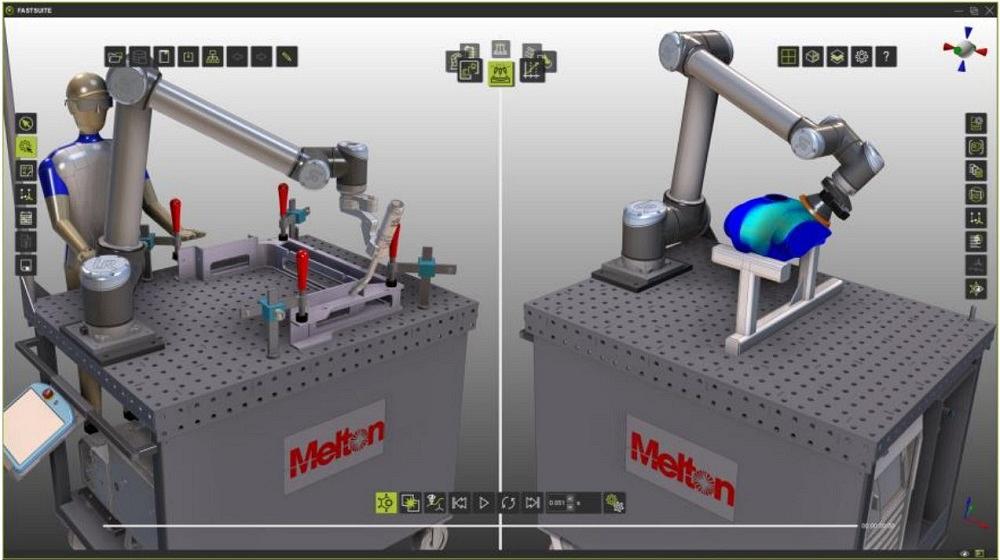- FMA
- The Fabricator
- FABTECH
- Canadian Metalworking
Categories
- Additive Manufacturing
- Aluminum Welding
- Arc Welding
- Assembly and Joining
- Automation and Robotics
- Bending and Forming
- Consumables
- Cutting and Weld Prep
- Electric Vehicles
- En Español
- Finishing
- Hydroforming
- Laser Cutting
- Laser Welding
- Machining
- Manufacturing Software
- Materials Handling
- Metals/Materials
- Oxyfuel Cutting
- Plasma Cutting
- Power Tools
- Punching and Other Holemaking
- Roll Forming
- Safety
- Sawing
- Shearing
- Shop Management
- Testing and Measuring
- Tube and Pipe Fabrication
- Tube and Pipe Production
- Waterjet Cutting
Industry Directory
Webcasts
Podcasts
FAB 40
Advertise
Subscribe
Account Login
Search
Brand-agnostic software helps robot integrator overcome supply shortage
- August 11, 2022
- News Release
- Manufacturing Software
Situation
As labor shortages and calls for higher productivity fuel demand for more automation, robot suppliers are striving to meet demand for their products. Robot sales in North America set a record in 2021, with 39,708 units sold, a 28% increase over the previous year, according to the Association for Advancing Automation.
Although this postcrisis boom is expected to subside in 2022, robots will continue to be in high demand. Longer lead times may stretch robot integrators thin.
Melton Machine & Control Co., a Washington, Mo., system integrator that designs and builds robotic arc welding cells and other automation systems for the automotive, agriculture, and construction industries, recently faced one such lead time challenge.
The integrator had an issue with a material handling project that was already designed around a particular brand of robot. That robot’s manufacturer said it would be unable to deliver the robot in the expected time frame, and the new lead time would be 36 weeks.
Unable to wait that long, Melton Machine had to substitute a different robot brand with a shorter lead time. This might seem like a simple process, but integrators must consider different robot reach and axis limits when designing the layout for an automation cell. And simulating that type of change in the original robot manufacturer’s software would require a lot of time and effort for the company to reprogram in the new robot’s brand-specific software.
Resolution
For Melton Machine, the swap was simplified with the use of Fastsuite simulation and offline programming software from Cenit. It creates 3D simulations of entire automaton cells before they are built, and the brand-agnostic platform allows integrators to substitute different robot arms when a robot supplier’s lead time could delay a project.
The software supports a library of more than 800 robot arms from all major manufacturers, handling reachability studies and axis limits regardless of the robot brand or process, whether it’s material handling, welding, material removal, or assembly.
“If we do the simulation in Fastsuite and then the customer wants to specify a different robot or we need to swap it out due to a supply chain issue, we’ll still need to reprogram, but all the fundamentals are already there,” said Glenn Archer, vice president of sales and marketing. “The advantage is that any robot you grab, all the limits are already set up, so robot reach studies and other parameters are already handled. It’s quicker and less expensive to change out the robot if we’ve done it through the Fastsuite path.”
With the software, Melton Machine was able to swap out a different robot and drop it into the existing simulation. “We were able to get the new robot in eight weeks and turn it around quickly,” said Archer. “The customer was back on track!”
Related Companies
subscribe now

The Fabricator is North America's leading magazine for the metal forming and fabricating industry. The magazine delivers the news, technical articles, and case histories that enable fabricators to do their jobs more efficiently. The Fabricator has served the industry since 1970.
start your free subscription- Stay connected from anywhere

Easily access valuable industry resources now with full access to the digital edition of The Fabricator.

Easily access valuable industry resources now with full access to the digital edition of The Welder.

Easily access valuable industry resources now with full access to the digital edition of The Tube and Pipe Journal.
- Podcasting
- Podcast:
- The Fabricator Podcast
- Published:
- 04/16/2024
- Running Time:
- 63:29
In this episode of The Fabricator Podcast, Caleb Chamberlain, co-founder and CEO of OSH Cut, discusses his company’s...
- Trending Articles
Tips for creating sheet metal tubes with perforations

Supporting the metal fabricating industry through FMA

JM Steel triples capacity for solar energy projects at Pennsylvania facility

Are two heads better than one in fiber laser cutting?

Fabricating favorite childhood memories

- Industry Events
16th Annual Safety Conference
- April 30 - May 1, 2024
- Elgin,
Pipe and Tube Conference
- May 21 - 22, 2024
- Omaha, NE
World-Class Roll Forming Workshop
- June 5 - 6, 2024
- Louisville, KY
Advanced Laser Application Workshop
- June 25 - 27, 2024
- Novi, MI


























